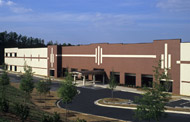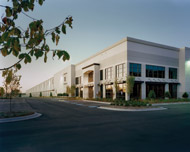|
COVER STORY, APRIL 2011
INDUSTRIAL STRENGTH
After setbacks during the down economy, Atlanta’s industrial market is poised for a strong recovery.
Jaime Lackey
The Atlanta industrial market has an advantage. “Atlanta is the hub of the Southeast. It is the job and population engine for the region — and the point where three interstates cross. As such, our industrial market continues to be the strongest in the Southeast,” says Doug Smith, senior vice president with Atlanta-based Seefried Properties, which develops and manages industrial space nationwide. The company currently manages 8.3 million square feet of industrial space in Atlanta.
During the downturn of the last 3 years, industrial transactions in Atlanta focused on big box spaces, Smith says. “Companies like Kraft, Clorox, and Phillips-Van Heusen used the downturn to consolidate and execute deals when it was economically advantageous,” Smith notes. “However, in the last 6 months, we’ve seen a return of deal velocity in the 15,000- to 50,000-square-foot range. In the northeastern I-85 corridor alone, companies have signed more than 350,000 square feet of smaller leases in 4 months [from December 2010 to March 2011].”
Jay Mitchell agrees. “Currently, Atlanta is seeing a general increase in activity from the small to medium-sized space users in the 15,000- to 50,000-square-foot range. This activity is typically from tenants renewing or relocating in their current submarket for 3- to 5-year lease terms. The larger space users are not as active as they were a year ago,” says Mitchell, senior vice president and regional development officer with Atlanta-based IDI, which develops and manages industrial properties across North America. The company currently manages 9 million square feet of industrial space in Atlanta.
Mitchell further explains, “At the end of 2009 and the beginning of 2010, the trend for smaller tenants up to midsized tenants in the 50,000-square-foot range was to renew for short terms of 1 to 2 years with some reduction in leased square footage. In that same time period, larger tenants in the 600,000- to 1 million-square-foot range were consolidating multiple locations into existing or build-to-suit locations in order to improve efficiencies and reduce expenses. These larger tenants were also in a position to sign longer-term leases to take advantage of the depressed rental rates.”
 |
In first quarter 2011, Electrolux leased 600,000 square feet at 7780 Spence Road in Fairburn, Georgia, from ING Clarion Partners.
|
|
Chip Watson, principal with Avison Young’s Industrial Properties Group in Atlanta, notes that there are still some very large transactions taking place. Watson points out that the south side of Atlanta saw 2 million square feet of industrial absorption with the closing of three large transactions in south Atlanta in late February and early March. Vacuum manufacturer Electrolux leased 600,000 square feet at 7780 Spence Road in Fairburn, Georgia. Avison Young represented landlord ING Clarion Partners in the transaction. Avison Young also represented ING Clarion in a deal to lease 226,000 square feet at 5003 Terminus Drive in Fairburn to Aaron Rents. In Palmetto, Georgia, Cushman & Wakefield brokered the sale of a 1.2 million-square-foot former General Services Administration building to Lowe’s Home Improvement.
“It will be interesting to see first quarter vacancy numbers, after transactions like this,” Watson says. In the meantime, Avison Young’s fourth quarter 2010 Atlanta industrial market report (based on CoStar data) showed that the overall vacancy rate decreased to 14.1 percent after 1.96 million square feet of space was absorbed during the quarter.
Smith predicts that industrial rental rates will start to climb in the markets where vacancies are improving by the second half of this year. The I-85 corridor in Duluth, the I-75 corridor north of Atlanta in Kennesaw and Marietta, and the airport submarket will see rent growth sooner than other submarkets.
“While landlords are being aggressive to keep existing tenants and close new deals, the market is starting to tighten,” Watson says. “We will see continued improvement — assuming we experience no major crises and oil prices don’t go through the roof. Companies will become more confident in their business operations and spending — and financing should get a little easier.”
Matt Tritschler, principal with Avison Young’s capital markets group in Atlanta, says that 2011 looks promising for investment sales in Atlanta’s industrial market. After 3 years of sidelined investors and limited product on the market, increasing interest from investors will entice more companies to put properties up for sale this year, he says.
According to Real Capital Analytics, Atlanta’s industrial investment sales volume went from a high of $1.7 billion in 2006 to $203 million in 2009. In 2010, investment sales climbed back up to the $596 million mark.
Tritschler says investors are looking for buildings of 250,000 square feet or larger with quality tenants in Atlanta’s northeast, northwest and south/airport submarkets.
On the development side of the equation, spec projects are likely a couple of years away. “I don’t anticipate new speculative development for some time to come. The demand isn’t there,” Mitchell says. He cites CoStar’s Atlanta industrial stats: net absorption for 2008 was negative 2.4 million square feet, 2009 was negative 5.7 million square feet, and 2010 was negative 2.8 million square feet.
“I do believe, however, that Atlanta will see a few build-to-suit for lease or ownership deals each year,” Mitchell adds. “Also, I believe that preleasing will begin to pick up over the next 12 to 18 months thereby contributing a limited amount of new development and speculative space to the market.”
 |
In March 2010, Colgate leased a 750,000-square-foot, LEED Silver-certified building at IDI’s WestPoint development in Douglas County, Georgia.
|
|
He notes that IDI has completed a couple of projects in the last 18 months. In March 2010, IDI leased a 750,000-square-foot building to Colgate at IDI’s WestPoint development in Douglas County, Georgia. “WestPoint A is LEED Silver-certified, which is one of the reasons Colgate was interested in the property. It is built in a sustainable manner with energy-efficient features that will lower Colgate’s energy and water usage,” Mitchell says.
IDI also completed a 1.15 million-square-foot build-to-suit project for a consumer products company at the company’s SouthCreek site in Fairburn, Georgia, in January. “This tenant consolidated several locations into this building, which resulted in a more efficient operation. This build-to-suit has been submitted for LEED Silver certification as well,” Mitchell says.
According to Mitchell, many industrial users are interested in sustainable or LEED-certified buildings — or buildings that incorporate green features that reduce operating costs. He says, “Many LEED features do reduce operating costs. For example, plumbing fixtures and landscaping designed to use less water and high-efficiency lighting designed to use less electricity.”
Smith says that he has not seen substantial demand for official LEED-certified industrial buildings from Seefried Properties’ clients; however, his clients also are interested in sustainable features that impact the bottom line. For example, high-bay T5 lights with motion sensors are becoming standard due to tenant preference.
Smith agrees that development over the next few years will be primarily build-to-suit activity. He, too, thinks preleasing activity will pick up soon, and he notes that Seefried Properties is likely to start construction on a 140,000-square-foot building at Satellite North Distribution center in the Suwanee/Buford area of metro Atlanta sometime in 2012.
“Tenants are becoming more confident. We’re seeing companies that are serious about deals, not just kicking the tires,” Smith says.
New Economic Development Initiatives Will Drive Industrial Growth in South Atlanta
New opportunity zones in south Atlanta will lure industrial users with state tax credits worth $3,500 per year for 5 years for each job created. To qualify, a company must create at least two new jobs within the opportunity zone. There is no maximum number of jobs that can qualify for the credit. In a very basic example, if a company creates 10 new jobs within an opportunity zone in one year and those jobs are maintained for 5 years, the tax credit will be worth $175,000 over the 5-year period. Additional jobs can be created each year for several years and the tax credits will increase accordingly.
The Southside Industrial Opportunity Zone, which totals 1,151 acres, was approved in March. This opportunity zone includes the 250-acre Southside Industrial Park. The Atlanta Development Authority has more than 90 acres of developable land inside the park. AMB Property Corporation, the Atlanta Housing Authority and the airport also own land within the opportunity zone.
“It’s an industrial-zoned area in southeast Atlanta between I-75 and I-285 with great transportation access by truck, rail or plane that includes vacant land and existing buildings,” says Sonya Moste, director of marketing with the Atlanta Development Authority.
The Fulton Industrial Boulevard Opportunity Zone, which is located southwest of Atlanta at I-20, was established in September 2010 and encompasses approximately 2,720 acres, including the unincorporated Fulton Industrial corridor from Charlie Brown Airport south to approximately Great Southwest Parkway. The zone essentially covers the northern half of the Fulton Industrial corridor.
“Opportunity Zone tax credits will encourage reinvestment in the northern half of the Fulton Industrial corridor where it is most needed. We hope this tax incentive will attract more manufacturing jobs to Fulton County,” says Vicki Coleman, business relations manager with Fulton County, Georgia.
Business owners in the Fulton Industrial area are also working on economic development initiatives. Several commercial property owners formed the Fulton Industrial Community Improvement District (CID) in October 2010. They are working with police to improve safety in the area, to upgrade landscaping, and improve transportation infrastructure. The group is also working on an economic development plan that will coordinate the efforts of complementary organizations, including the South Fulton Chamber of Commerce, the Metro Atlanta Chamber of Commerce, Fulton County, and Georgia Power.
Although the Fulton Industrial CID is south of the Fulton Industrial Boulevard Opportunity Zone, CID board members supported the opportunity zone designation and worked with the state to get the designation approved. “These initiatives benefit everyone in the area. Improving the northern section of the Fulton Industrial corridor will lift property values in the southern section of the corridor as well,” says Tom Flanigan, chair of the board with the CID and regional asset director with ING Clarion, which owns 5 million square feet within the Fulton Industrial CID. (For information about joining the Fulton Industrial CID, contact Flanigan at Tom.Flanigan@ingclarion.com.)
As the year continues, there may be more economic development news coming from Atlanta. “We are waiting to hear from the state on another 31 areas that were submitted for opportunity zone designation,” Moste says.
— Jaime Lackey |
©2011 France Publications, Inc. Duplication
or reproduction of this article not permitted without authorization
from France Publications, Inc. For information on reprints
of this article contact Barbara
Sherer at (630) 554-6054.
|
